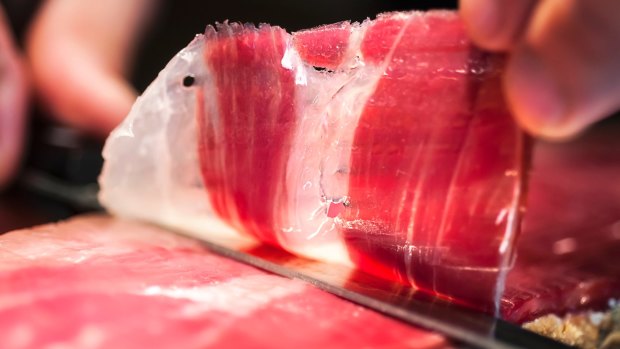
Jamon iberico is a cultural icon – the Real Madrid of ham, the Penelope Cruz of pig.
Only a few hours after arriving in Spain I find myself asking Google: is jamon healthy? You'll hear the repeated assurance from locals that jamon iberico, the fervently worshipped, long-cured back leg of the Iberian black-footed pig, is some sort of miracle product. It's low in cholesterol, they say, due to the pigs' acorn diet in the last four months of their lives. It's actually good for you, they claim with straight-faced sincerity, in the way of the so-called "good fats" of avocado, or olive oil.
Yes, the jamon iberico is, in a Spanish turn of phrase we hear again and again, very "ecological". The argument goes like this: the pigs roam free while feasting on acorns, the exercise forcing the fatty oils into the flesh, upping their quotient of oleic acid (a good thing, by all accounts) while giving it the characteristic marbling effect.
So did the Spanish just get in early on the alternative fact world – or might there be a kernel of truth to their argument? The population isn't exactly suffering the obesity crisis witnessed across Australia, despite ham being consumed in heroic quantities at breakfast, lunch and dinner. Forty-six million people aren't swapping their time-honoured eating habits for the healthy diet pyramid. Instead they're all thumbing their nose at the World Health Organisation's declaration that cured meats are carninogens, and getting on with the serious business of eating delicious ham.
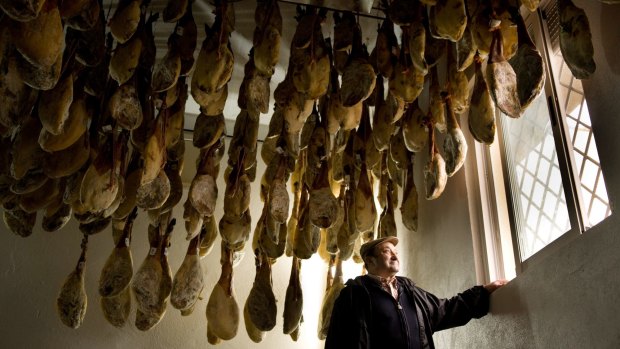
Faustino Prieto, owner of an Iberian ham business, with legs of dry-cured jamon iberico de bellota.Credit: Getty Images
Wherever you are in Spain, jamon is inescapable. From Madrid's vibrant Museo del Jamon chain of cafes, where the ceiling is lined with jamon by the dozen with hoofs attached (la plata), to the capital's upmarket Villa Magna hotel where an Iberico leg is a centrepiece of the breakfast buffet; from the nation's Michelin-starred heights to its raucous tapas bars, the clamped hind leg and the sharp knife is as much a fact of life as breathing.
It would be enough to eat ham in Spain, every meal, every day – a challenge my compadres and I set ourselves, and one that proves unerringly easy to achieve – but getting the inside running on these royal pigs leads us to Luis Mariano Cordero, the owner of Geoactiva Adventures. His jamon safari in the rugged region of Extremadura, one of the natural homes of the black-footed pig, takes us bush bashing, Spanish-style, in his four-wheel-drive through the sun-hammered dehesa – a sprawling, yet managed, network of oak forests.
About 30 minutes' drive from the UNESCO World Heritage town of Caceres there are plenty of oak trees to be seen, some of them 800 years old, but today the pigs are proving elusive. Perhaps they've heard where eating six kilograms of acorns a day in a four-month frenzy will get them.
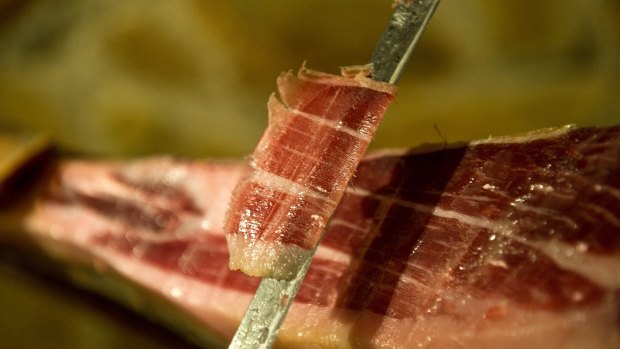
The pigs roam free while feasting on acorns, the exercise forcing the fatty oils into the flesh, upping their quotient of oleic acid and giving it the characteristic marbling effect. Credit: Getty Images
The gospel of jamon according to Mariano is fairly straightforward. The black-footed Iberian pig is not to be confused with its garden-variety white-footed brethren, who make the lesser jamon serrano. The top-grade jamon iberico de bellota (bellota denoting its pure acorn diet in the last few months of life) is famous across the world, in the way of Beluga caviar, Kobe beef and Alba truffle; jamon serrano is simply nice ham. "They have the bad grease because they eat everything!" says Mariano; "the black pigs have the healthy fat because they only eat acorns."
Furtive though the pigs are being today, their road will inevitably lead to a place like the father and son-operated Jamones Alvaro Galan in the hillside town of Montanchez, where the dry climate lends itself to the 3½-year curing process, which starts with the hams being packed in salt for one day per kilo of weight, then washed, dried and hung. Stalactites of jamon hang from every inch of the factory's ceiling; a forest of black hooves dangle at head height, natural flora forming on the skin, the surrounding air crystalline-rich.
The natural end point of our paddock-to-plate experience comes in the moody stone cellar of the nearby La Bodega de Perez, watching owner Carlos Perez finish a plate of jamon with a central rosette made of pure pig fat. Questioning reveals, yes, we're meant to eat it; pancreatitis be damned. "You eat the very best jamon on its own, you don't mix it with cheese and bread," commands Carlos. His business card proclaims him cortadores de jamon – a master carver – and there's no denying his skill with the long, thin, flexible blade known as a jamonero, even before we discover he has reigned supreme at one of the national competitions that attract thousands of spectators.
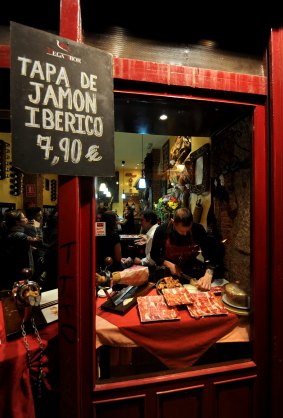
The Spaniards are champion jamon eaters.Credit: Getty Images
Yes, ham carving is back in vogue. Professional cutters like Carlos are in hot demand. Religion is on the decline in Spain but the worship of jamon is unassailable, and no self-respecting society event or wedding these days would be complete without a designated jamon carver.
Carlos lets us in on another secret: the pata negra – black foot – of the Iberico jamon is occasionally a fake, painted onto the serrano by charlatans looking to make a quick buck. As the Romans who started this whole jamon business would have said, caveat emptor.
But wait, there's more. Vegetarians in Spain will commonly eat jamon, because it's seen as something that transcends the prosaic category of "meat". Cultural icon, more like it. It is the Real Madrid of ham. It is the Penelope Cruz of pig. Eight days of eating jamon at every meal and instead of having a bored palate I'm in the throes of a full-blown addiction. The sweet, salty fat achieves that terrible cliche of food writing by actually melting in the mouth; the long-lasting umami hit of the flesh is indescribable.
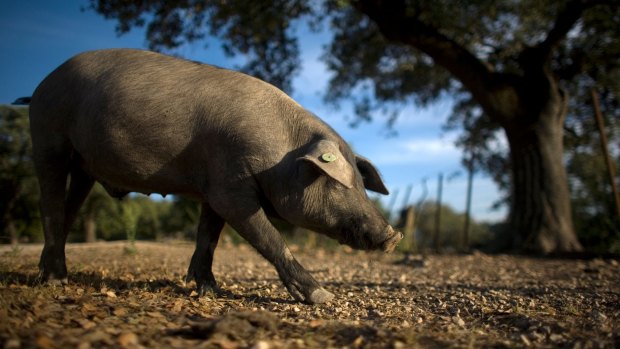
Jamon iberico comes from the long-cured back leg of the Iberian black-footed pig.Credit: Anne Lewis
It will come as no surprise that the Spaniards are champion jamon eaters, each of them eating upwards of 3.5 kilograms a year. "We eat ham at every meal," says Carlos. "We drink, we eat ham. We snack, we eat ham." Maybe – just maybe – they're a nation poised on the brink of suicidal self-delusion. But their jamon is so delicious, this is one alternative fact world I'm happy to be part of.
TRIP NOTES
MORE
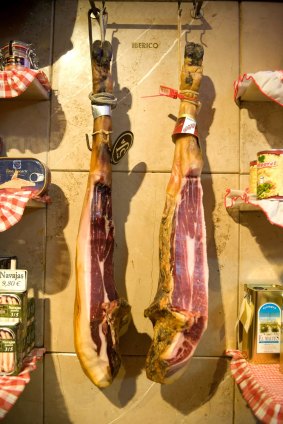
Dry-cured legs of jamon iberico de bellota.Credit: Getty Images
Emirates airlines flies from Sydney and Melbourne to Madrid, see emirates.com/au. Extremadura is best reached by road; hire a car or use a service such as Transfer Extremadura, see transferextremadura.com.
STAY
The four-star Hotel NH Palacio de Oquendo, centrally located in the Old Town of Caceres; rooms start from €95 a night, without breakfast, see nh-collection.com
TOUR
Jamon safaris are run by GeoActiva Adventuras; €30 per person, see facebook.com/rutasgeoactiva
Larissa Dubecki was a guest of Turespana, the Spanish Institute of Tourism.
Sign up for the Traveller Deals newsletter
Get exclusive travel deals delivered straight to your inbox. Sign up now.